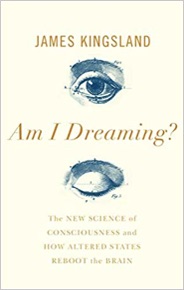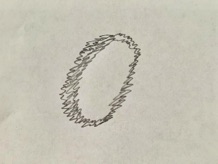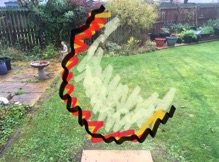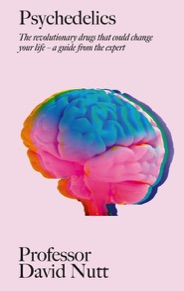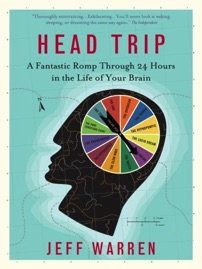The Science of Consciousness:
Chapter 11: Altered States of Consciousness
What this chapter is about: What are Altered States of Consciousness (ASCs), and what do they tell us about "normal" consciousness?
What is altered in an altered state? This chapter covers the definition of altered states, plus discussion of some of them, including sensory deprivation, ganzfeld, out-of-body experiences, near-death experiences, migraine, epilepsy, and encephalitis lethargica.
I think more coverage is due of Charles Tart's work on ASCs, defining an ASC as a qualitative change in consciousness. I would add some discussion of consensus reality.
Near-death experiences
This material now has its own page.
I think in any future edition I would move the material on NDEs (near death experiences) to the chapter on parapsychology, with survival, or possibly create another chapter.
Breathwork
I would now add a section on holotropic breathwork - adjusting your breathing rate to enter an altered state. See How to do holotropic breathwork and Breathwork. As ever there is some controversy about its exact therapeutic value, and a few concerns about safety.
Consciousness in the news
Sleeping sickness. Suzanne O'Sullivan's description of "sleeping sickness" or children with resignation syndrome in Sweden has been much covered in the news recently (late March 2021, for example here in the New Statesman. I will review the book Sleeping Beauties as soon as possible below; it looks fascinating. Resignation syndrome is distinct from sleepy sickness, encephalitis lethargica, discussed in this chapter if my book. It is as if these immigrant children, who have had terrible lives, have just given up, and appear to be unresponsive and sleeping all the time. They appear to be in a coma - but aren't. The EEGs are very different and they show normal sleep-wake patterns. Now trauma in chidlhood is sadly not uncommon around the world, but it is only these children iof immigrants in Sweden who show resignation syndrome. So what is going on? The children have heard of other children doing the same thing, so a kind of mass hysteria (see Chapter 7 of my book) kicks in. To call it mass hysteria is not to belittle it; the children don't seem to know consciously what they are doing. The are not faking anything. It's a peculiar state of consciousness related to akinetic mutism (see Chapter 3).
Early cave art and hypoxia. In mid-April 2021 there has been widespread coverage (e.g. here, here in the The Times, and here in the Independent) of the idea that early humans, in the Upper Palaeolithic in southern France and Northern Spain, deliberately chose deep caves where oxygen was in short supply in order to induce an altered state of consciousness. This ASC presumably enabled them to believe that they were in contact with some kind of divine, and influenced their depictions of animals.
Yafit Kedar, Gil Kedar & Ran Barkai (2021) Hypoxia in Paleolithic decorated caves: the use of artificial light in deep caves reduces oxygen concentration and induces altered states of consciousness, Time and Mind, DOI: 10.1080/1751696X.2021.1903177
Migraine
I have started sketching my own auras.
23/4/21. As with all my auras, it starts with a blind spot which expands, with my vision returning as the flashing zigzag lines move to the edge of my visual field. This one was distinctly egg shaped, with the flashing zigzags, unusually for me, staying monochrome. Early on the centre of the egg though had a distinct pink colour. I have been experimenting with Sumatriptan - I've only just come across this drug - in addition to a painkiller, but I can't say I've noticed that it makes very much difference. And if anyone has found something effective for the nausea, please let me know; I've tried buccal prochlorperazine (available over-the-counter in the UK) but again found it doesn't do much for me. (Buccal, a useful word meaning between the gums and cheek.)
17/10/22. I have tried here on the left to capture what it looks like as it develops.. This one was asymmetrical, as it often is, with the flashing lines on the left only, enclosing a grey scotoma (blind spot), again radiating outwards to fill the visual field, at which the pain starts. This one started about an hour after waking and was preceded by an unusally troubled night's sleep, with a few bad and very realistic and confusing dreams, and then an upset stomach. The day before I was exceptionally tired anf fell asleep unusually early - all of that is probably a sign of the prodromal phase. It takes about half an hour for the aura to grow and then disappear off the edge of the visual field. I have tried superimposing it on a visual scene to capture what it looks like as realistically as possible.
My other ASCs
My personal experience of ASCs apart from migraine is disappointingly limited. As a student in Cambridge I took part in many ganzfeld experiments, and have been mildly hypnotised a few times. My dreams are often very long, complex, and vivid (see Chapter 13 on dreams).
My most unusual experience happened on Sunday 13 June 2021. The fact that it was Sunday might be relevant: all my life I have experienced most migraines on a Sunday. I had just finished playing online chess, around 20.50, and was at my desktop computer in my study and realised that I couldn't remember what I'd been doing. I was in a fugue state, confused, had no memory of what I'd been doing or why. I noted at the time time that I was "absent" for 30-45 minutes, although that seems a very long time, and it might have been much less. I remember downloading the game, and then nothing. I noted that "nothing made sense". I was confused and had a feeling of profound awe and dread. I don't think I fell asleep, and in any case there were the other qualities of the experience such as confusion and dread. I don't have a good explanation. I was perhaps a bit dehydrated but that alone cannot explain the experience. Naturally at the time I worried that I had had a minor stroke. Perhaps it was some kind of TIA (transient ischemic attack - a temporary blockage to the blood flow of the brain), but the symptoms weren't typical (numbness, loss of speech). It was some kind of absence, and I can find little about what causes them.
OBEs (out-of-body experiences)
I am surprised by how widely it is believed that OBEs involve the relocation of some soul or "astral body" to outside the body. If you think that, my first question to you is: how does this astral body perceive the world? There are no sense receptors. No little astral eyes processing visual information. I am not denying people's experience, but arguing that the process and perception is some kind of halliucination. (One possible answer is that the "soul" gathers information by ESP, but there are obvious problems with this reply; see Chapter 17 on Parapsychology.)
On the left we see what I would see in an OBE in bed: the tip of Beau's nose peeping out.
Animal conceptions of death
On p. 258 I say "only humans have knowledge of death and its certainty". I shouldn't have been quite so pessimistic (and perhaps humanocentric) about how non-human animals behave. There is plenty of anecdotal evidence and observational work that showsthat some animals have some concept of death and grieve for the loss of children and mates. See for example:
https://en.wikipedia.org/wiki/Animal_grief
https://www.bbcearth.com/news/the-truth-about-animal-grief
I doubt if any (non-human) animal knows that they are going to die and worry about it, but of course it's very difficult to be sure.
See:
King, B.J. (2013). How animals grieve. Chicago: Chicago University Press.
Links to pages on Altered States of Consciousness
Susan Blackmore's web pages. Although author of a competiting text, I recommend her pages for discussion of many fascinating topics in consciousness research, particularly parapsychology, dreams, and altered states.
Further topics for discussion
1. Are mood disorders ASCs?
Further reading
Kingsland, J. (2019). Am I dreaming? The new science of consciousness and how altered states reboot the brain. London: Atlantic Books. Kindle version available. ISBN: 978-1786495501.
If you've seen the Ken Russell 1980 film Altered States, you might be under the impression that altered states are bad things. Not at all; meditation can help us relax and deal with stress, and hypnosis can help treat us for many physical and mental problems. Probably of most interest though is the work on hallucinogenic drugs, which have recently been shown to help with creativity, mental illness, finding meaning and purpose in life, and even helping us cope with fear of death, even in extremely small doses ("microdoses"). Kingsland's excellent and wide-reaching review covers all this material and more. It is approachable and clearly written, which is important given that he also covers the neuroscience of how things work. Much of the research with drugs was carried out by Robin Carhart-Harris and David Nutt, under special licence and medical supervision.
Nutt, D. (2023). Psychedelics: The revolutionary drugs that could change your life – a guide from the expert. London: Yellow Kite.
ISBN: 78152936053. Really is by an expert.
Warren, J. (2009). Head Trip: A Fantastic Romp Through 24 Hours in the Life of Your Brain. Oneworld publications.
ISBN 978-1851686513. I think this is a superb book, covering all of consciousness as well as a wide range of ASCs. Deserves to be better known.
